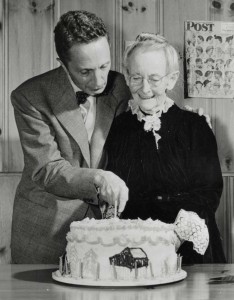
Photo of Norman Rockwell and Grandma Moses, circa 1949. Photographer unknown. Norman Rockwell Museum Digital Collections. ©Norman Rockwell Family Agency. All rights reserved.
Born on February 3, 1894 in New York City, Norman Rockwell always knew he wanted to be an artist. At the age of 14 he enrolled in art classes at The New York School of Art. Two years later, in 1910, he left high school to study art at The National Academy of Design. He soon transferred to The Art Students League, where he learned valuable technical skills from George Bridgman, and about illustration with Thomas Fogarty (Norman Rockwell Museum has recently acquired original artwork from both important artists).
Growing up with a love for the storytelling of Charles Dickens, Rockwell was naturally drawn to illustration. While still in his teens, he was hired as art director of Boys’ Life, the official publication of the Boy Scouts of America, and began a successful freelance career illustrating a variety of young people’s publications. But he always had his sights set on The Saturday Evening Post, which he considered “the greatest show window in America.” In 1916, the 22-year-old artist painted his first cover for the Post, which began a successful 47-year relationship, resulting in 321 covers for the magazine, and such important story illustrations as The Four Freedoms. Rockwell’s work became so popular with the public that the Post published additional copies (about 75,000) when one of the artist’s cover was to appear in the 1940s and 1950s in order to satisfy increased newsstand sales.
In 1953, Norman Rockwell and his family moved from Arlington, Vermont, to Stockbridge, Massachusetts, where the artist would go on to create many more iconic images, including those which addressed such topical issues as the Civil Rights movement, the founding of the Peace Corps, and man’s first steps on the moon.

Google honored Norman Rockwell’s 116th birthday in 2010 with this Google Doodle. It resulted in the temporary crashing of Norman Rockwell Museum’s Web site, which received over three million hits from curious Googlers and birthday well-wishers from such regions as North America, Europe, Asia, The Middle East, and South America. Talk about a birthday present! Artwork courtesy Google.
In 1973, the artist established a trust to preserve his artistic legacy by placing his works in the custodianship of the Old Corner House Stockbridge Historical Society, later to become Norman Rockwell Museum.
Norman Rockwell received the Presidential Medal of Freedom in 1977, and died a year later on November 8, 1978. His work has remained an inspiration for several generations; as NBC’s Brian Williams was quoted as saying, “critics insist Norman Rockwell was painting an ideal instead of reflecting a reality. Rockwell himself knew America was all about ideals. He saw his task: to remind us who we are, and what we aspire to be. That was… and is… Rockwell’s America.”
Related Links:

